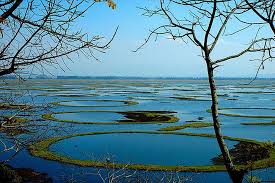Seventy years have passed since the Second World War and we are still discovering previously unidentified wreckages of fighter planes and wartime artefacts. Recently, three second world war fighter planes were found at the bottom of Lokatak Lake in Imphal, India.
Yumnam Rajeshwor Singh, founder of the Imphal Campaign Foundation who found these sites said, “The two Japanese fighter planes christened ‘Oscar’ were shot down by British bomber ‘Wellington’ before the latter was also hit in a pitched aerial battle on June 17, 1944”. The site was identified with the help of some local elders who have witnessed the air battles during World War II. They recalled how the fighter planes submerged in the sea after the air battles and that they saw floating dead bodies of six British crew members when Wellington was hit by the Japanese fighter planes. They were buried in the Imphal War Cemetery.
Rajeshwor said that some of the lighter parts of the plane such as its tail, wings, and posterior sections have been taken off and sold as scrap metal. However, the larger and heavier parts such as the engines still lay on the bottom of the lake as they could not be lifted and put on boats manually by the locals.
He also mentioned that there are other sites where there is a possibility of finding more such wreckages. He said that some fallen Second World War planes are still trapped atop huge trees in the deep jungles of Churachandpur and Ukhrul districts, The Times of India reports.
Manipur, India which was one of the centres of the Second World War battle between the Japanese and the British saw thousands of Japanese and Allied soldiers get killed and injured. It saw a lot of battles both on land and in the air and has got lots of sites where wreckages from these battles are still being found. Last year London’s National Army Museum recognised the twin Second World War battles of Imphal and Kohima as ‘Britain’s Greatest Battle’.
The Second World War Imphal Campaign Foundation’s newly set up museum exhibits thousands of Second World War artefacts. The artefacts range from guns and ammunitions used by both Japanese and Allied Soldiers to the Allied Khaki shirts and Oxygen cylinders used in the aircrafts. When asked about the sites and locations from where these artefacts were discovered Rajeshwor who is also a member of the Burma Campaign Society, London and the International Guild of Battlefield Guides, UK, told that he retrieved them, with the help of his volunteers, from various battle sites using metal detectors and other gadgets.
